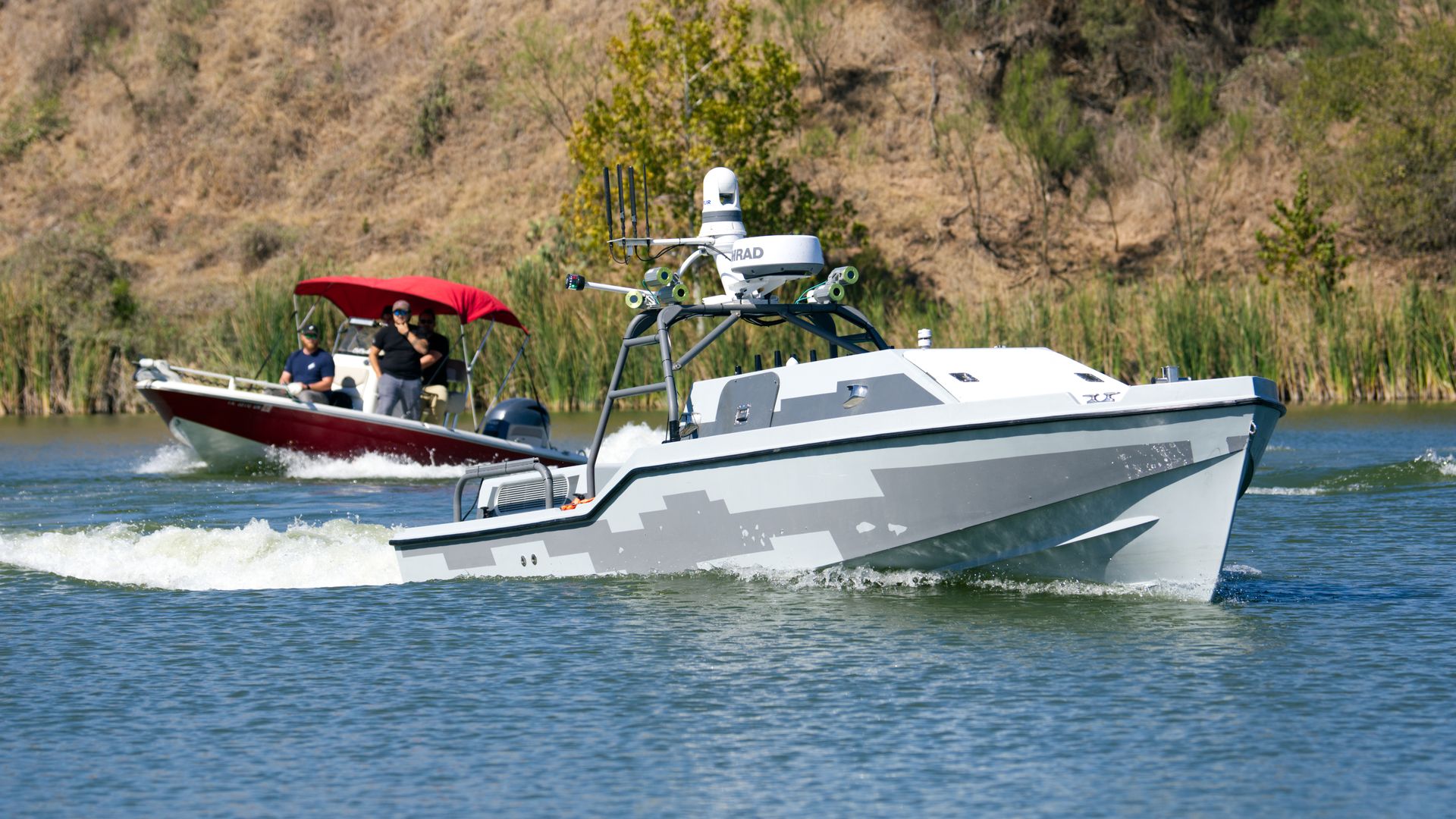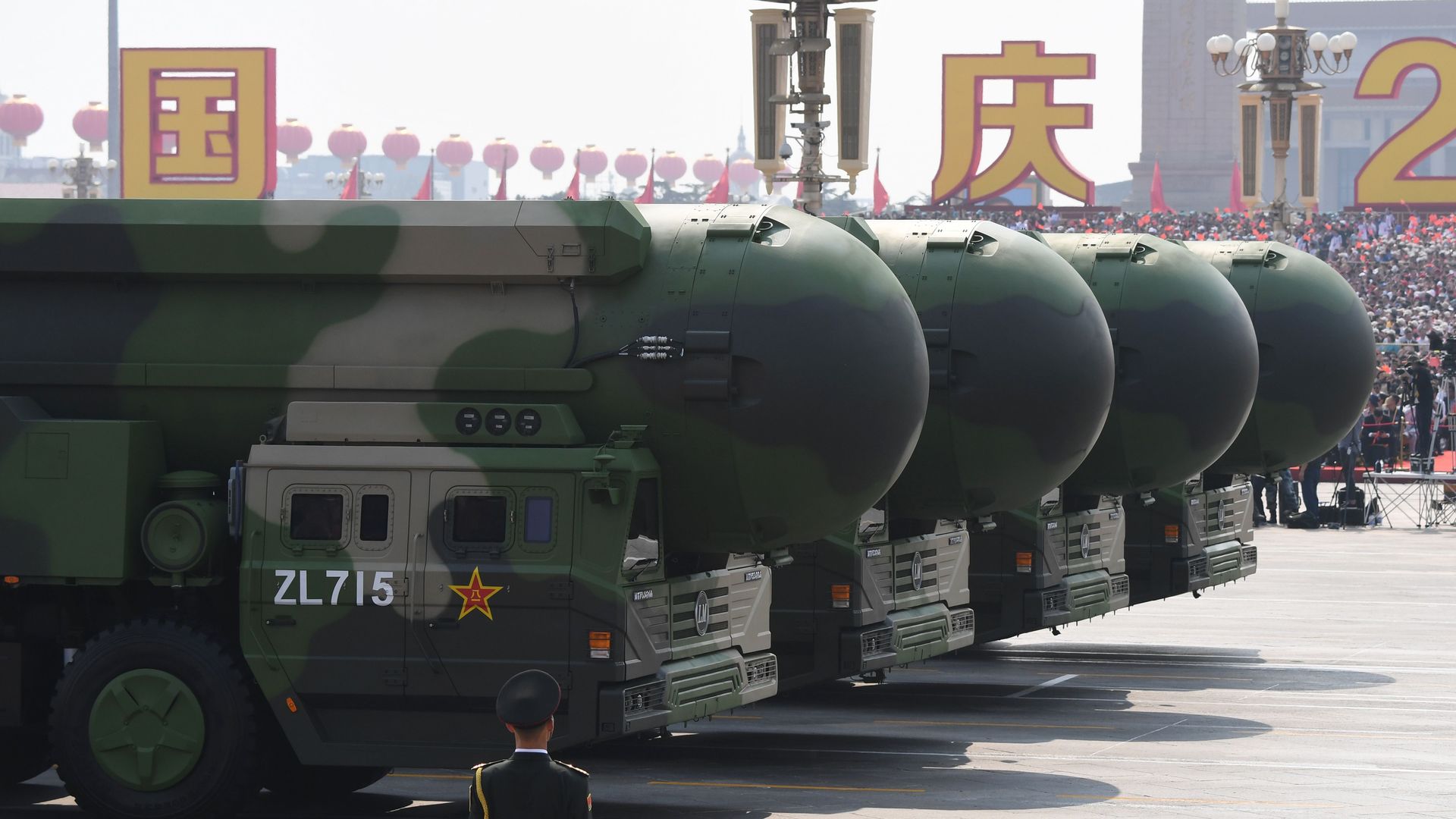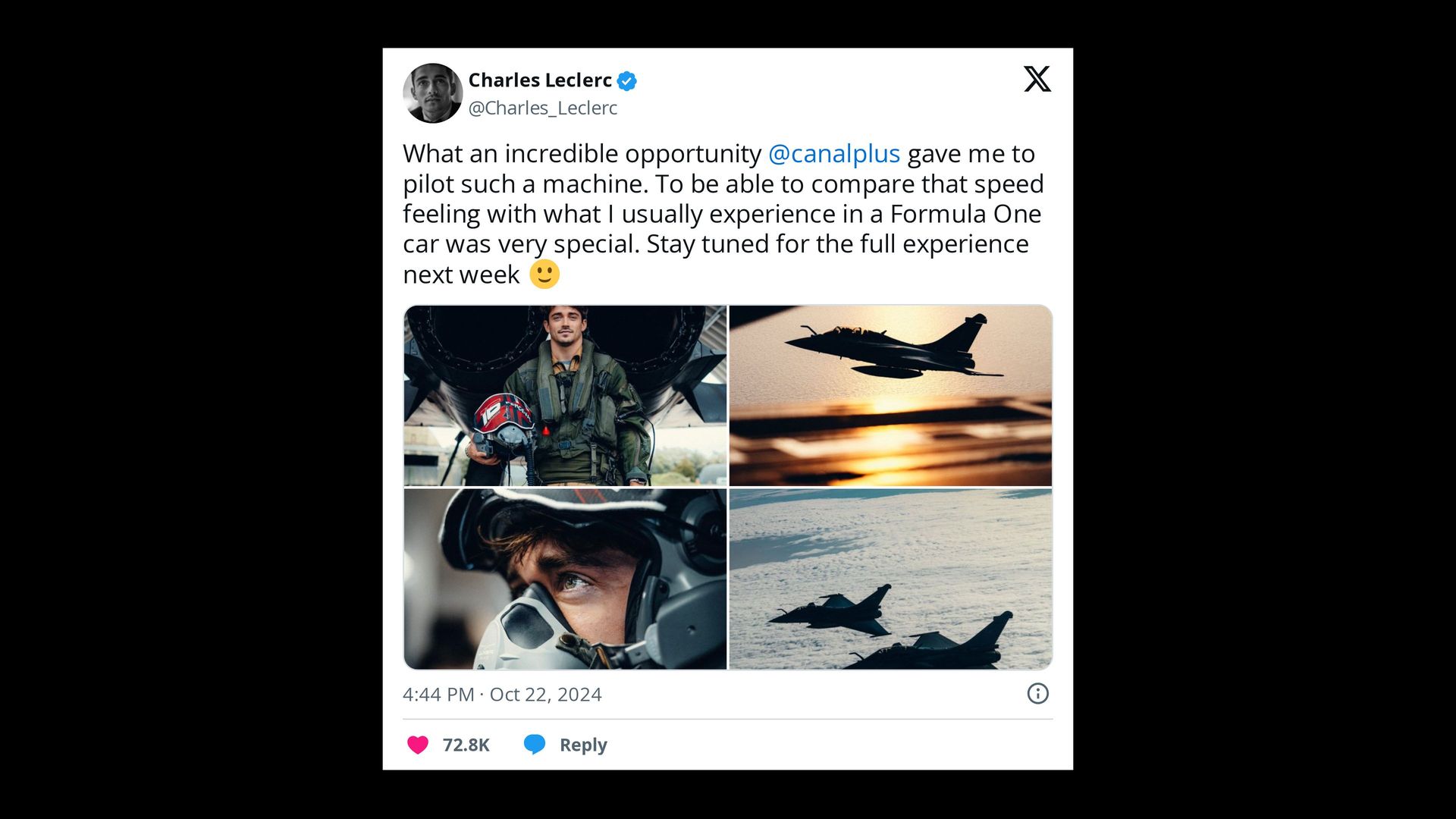| | | | | | | Presented By McKinsey & Company | | | | Axios Future of Defense | | By Colin Demarest · Oct 30, 2024 | | Happy almost Halloween. All treats, no tricks in this edition. 💣 Situational awareness: Artificial intelligence can enhance America's nuclear command, control and communications, Air Force Gen. Anthony Cotton, leader of Strategic Command, said Monday at the DODIIS conference. - My thought bubble: AI fortifying the most sensitive networks is great. Just make sure to keep a human around when we're talking nukes.
Scroll for: The Czech Republic's new planes, a chat with GDIT's Amy Gilliland, and Charles Leclerc. Today's newsletter is 1,552 words, a 6-minute read. | | | | | | 1 big thing: On the water with Saronic | | |  | | | Saronic's latest autonomous vessel, the 24-foot Corsair, undergoes testing in Texas. Photo: Colin Demarest/Axios | | | | To Dino Mavrookas, a single good boat doesn't matter. - "At the end of the day, how you change the maritime battlefield is through scale," Mavrookas, a former Navy SEAL, told me during an exclusive tour of his company Saronic's facilities in Texas. "Everything we do is, 'Can we get to thousands?'"
Why it matters: The U.S. is bracing for future conflicts waged on a grand scale — "total war," as a former Pentagon official described it this month in Foreign Affairs. Resource intensive. Widespread. Grueling. - That fight demands mounds of smart, cheap machinery. The Pentagon recognized this with Replicator, which initially sought to deploy thousands of readily available drones and now wants the weapons to knock them out.
- Companies are jockeying for attention. On and below the waves, that includes smaller firms like HavocAI and Saildrone and bigger players like HII and Northrop Grumman.
- Russia and China have taken heed, as well. Their advancements are popping up at expos as well as on social media feeds.
Driving the news: Saronic unveiled its third autonomous surface vessel, the 24-foot Corsair, earlier this month. It joins the 6-foot Spyglass and the 14-foot Cutlass, all of which are fabricated 15 minutes from the Austin airport. - Corsair can travel 1,000 nautical miles, carry 1,000 pounds and hit speeds greater than 35 knots. The fuel onboard weighs more than Spyglass and Cutlass combined.
- I watched Corsair navigate a nearby lake, which Saronic uses for on-demand assessments. It cut sharp turns and skimmed the tops of waves as it zipped past an observation dock.
Yes, but: Cruising around with a view of the Austin skyline is one thing. Surviving the Black Sea is another. - All of Saronic's boats go through "robust lake and ocean testing," Rob Lehman, the chief commercial officer, told me. "That's the Gulf of Mexico, that's the Atlantic, that's the Pacific, that's on our own, that's with customers."
- The company said it has government contracts but declined to specify customers and values. (Some vessels participated in the Integrated Battle Problem 24.1 exercise.)
Friction point: The Navy has a very public shipbuilding problem. The service's priority boats are years behind schedule with few fixes in sight. - "In this line of work, the technical overmatch is irrelevant if you can't produce it, if you can't sustain it and if you can't deliver it to the forward edge," former Chief of Naval Operations Adm. Michael Gilday said in an interview.
- Gilday is advising Saronic. While in uniform, he called for hundreds of manned and unmanned ships fighting together.
By the numbers: Saronic has raised more than $250 million. - Its 200-plus employees include Anduril Industries, Liquid Robotics, Shield AI and SpaceX alumni.
What we're watching: Will the company's mass-production plans match Pentagon dollars? And how will Corsair, fresh off the factory floor, perform under fire? The bottom line: There's an unmanned arms race underway. Ignoring its naval implications — off the coast of Yemen, for example — would be foolish. Share this story |     | | | | | | 2. Israel's lasers | | |  | | | The Iron Beam laser weapon, seen behind U.S. President Joe Biden. Photo: Gil Cohen-Magen/AFP via Getty Images | | | | Israel is spending more than $500 million to ramp up production of Iron Beam, a futuristic laser meant to shield the country from mortars, rockets and drones. Why it matters: The funds vouch for directed-energy weapons, which are not yet widely adopted and polarize defense-tech watchers. - The push underscores the severity of overhead threats Israel faces. More protections are needed to thwart more salvos from more aggressors.
Iron Beam should be ready within a year, according to Eyal Zamir, the director general of Israel's defense ministry. - Its realization, he added in a statement, "heralds the beginning of a new era in warfare."
Zoom in: Rafael Advanced Defense Systems leads development of Iron Beam. The company is also involved with the vaunted Iron Dome and David's Sling countermeasures. - Chief executive Yoav Tourgeman said Iron Beam will greatly enhance Israel's air defenses, which have been strained by Iran and its proxies.
Flashback: Iron Beam was the subject of much misinformation following the 2023 Hamas raids. - Videos purporting to show the high-energy laser in action — destroying a barrage of incoming missiles — were actually manipulated clips from a photorealistic video game, Arma 3.
The bottom line: Militaries around the world are wrangling with directed energy. Israel could be its proving ground. Share this story |     | | | | | | 3. Quick hits | | |  | | | DF-41 missiles are paraded through Beijing in 2019. Photo: Greg Baker/AFP via Getty Images | | | | ☢️ China is executing an "ambitious" overhaul of its nuclear arsenal, outpacing previous U.S. estimates, the Defense Intelligence Agency said in its latest public accounting of the devastating weapons. - Why it matters: Beijing "has not declared an end goal nor acknowledged the scale of its expansion," the agency said. Meanwhile, it shrugs off arms-control talks.
- 💭 My thought bubble: Zoom out for some much-needed perspective. China has a long way to go before it matches the stockpiles of the U.S. and Russia.
📦 Embraer is expanding its NATO footprint, as the Czech Republic orders a pair of C-390 Millennium transport aircraft. They can shuttle troops and equipment as well as perform air-to-air refueling. - Why it matters: The company wants to stake a larger claim in the U.S. market and has eyed the Air Force's Next Generation Air Refueling System.
- 💭 My thought bubble: A growing profile abroad could sway buyers stateside.
💳 Aerospace and defense companies will pour resources into rocket, space and unmanned technologies in the coming months, according to Deloitte. - Why it matters: "The year 2025 for the aerospace and defense industry may end up being defined by the word 'operationalize,'" the consulting giant said in its latest outlook. "Growth across the industry is likely to continue with technology underlying each step."
- 💭 My thought bubble: Told you so.
|     | | | | | | A message from McKinsey & Company | | Why smart leaders are looking to space for growth | | |  | | | | The space economy is set to reach $1.8 trillion by 2035, with technologies solving earthly problems across industries. Take note: McKinsey research reveals how space innovations are creating new opportunities for companies in every sector. Explore space opportunities. | | | | | | 4. Axios interview: Amy Gilliland | | |  | | | Photo illustration: Axios Visuals. Photo: Courtesy of GDIT | | | | This week's conversation is with Amy Gilliland, the president of General Dynamics Information Technology. - We met at the company's headquarters in Falls Church, Virginia.
- On the way out, I grabbed a sandwich from the cafeteria. It was delicious.
Why she matters: Gilliland, a former U.S. Navy surface warfare officer, leads a division of General Dynamics shaping everything from cybersecurity policy to artificial intelligence adoption. - General Dynamics is the fifth-largest defense contractor in the world when ranked by defense-related revenue, according to Defense News.
Q: When you hear "future of defense," what comes to mind? A: Technological superiority, and connectivity and collaboration. Specifically, the nature of the threat is changing, given the geopolitical environment that we find ourselves in. - We have to be highly adaptable and resilient. We see Ukraine as an example of how asymmetric threats are being used against conventional weapons. Information dominance is part of that connectivity and collaboration.
Q: What's the biggest challenge the defense industry faces at the moment? What can be done to alleviate it? A: People. Attracting and retaining the workforce. We have a very mature workforce, and we have a new workforce. - We have a net shortage of people. So how we attract and then retain the next generation of workers in this industry is definitely a challenge.
Q: What region of the world should we be watching? Why? A: I don't think we have the luxury, in the current geopolitical environment, to focus on just one region. With that being said, there is certainly a focus on Indo-Pacific Command as an emerging theater. - The ability for us to collaborate and communicate, the connectivity at the edge there, just getting there, is enormous, and the complexity of that. So one thing, in particular, would be contested logistics.
Q: What's your secret to a successful overnight flight? A: I was in the Navy, and what I learned in the Navy is that I can sleep anywhere. I can sleep on my head, I can sleep in any space, I can sleep with crying children, I can sleep through anything. Q: What time do you wake up? What does the morning routine look like? A: Very early — uncivilized hours for most. - I have three small children, so I like to get a workout in. You'll find me at Orange Theory, the first class of the day. Get a good workout in, sweat and then go home, get the kids off to school and come to the office.
Q: What advice would you give your younger self? A: One, be open-minded about your career. I've had a lot of opportunities that I did not either feel prepared for or were not on my internally pre-established career evolution, and they have turned out to be some of the best experiences of my career. - Two, I would tell myself to be present where you are. As a working mother, it is easy to worry about my children when I'm at work and to worry about work when I'm with my children. Somebody gave me that advice, and I find that hugely helpful.
Share this story |     | | | | | | 5. Check this out | | |  | | | Charles Leclerc sets purple times in all sectors aboard a Rafale fighter jet. Photo: Charles Leclerc/via X | | | | F1 driver Charles Leclerc, known for his inability to convert pole positions to race wins, participated in a French Air Force training mission aboard a Rafale fighter jet. Why it matters: It's a super-cool crossover. A side quest. Whatever. Don't overthink it. What they're saying: In a "Top Gun"-style sizzle reel shared on Instagram, Leclerc's asked if he is "ready to go supersonic." - "I know I will pull a good amount of Gs, but that's it," the Monégasque driver says.
My thought bubble: Put me in your jet. Bring me on your ship. Let me ride in your tank. I'm game — just like Leclerc. |     | | | | | | A message from McKinsey & Company | | Five strategies for defense tech success | | |  | | | | Successful defense tech disruptors are employing key strategies to overcome industry challenges. The strategy: - Scale from the outset.
- Partner with established players.
- Pursue dual-use applications.
- Integrate software and hardware.
- Tailor sales capabilities.
Get McKinsey's insights. | | | | Shoutout to Nicholas Johnston for editing and Matt Piper for copy editing. 👋🏼 Thanks, as always, for reading and sharing. Tell your friends to subscribe, here. |  | Your essential communications — to staff, clients and other stakeholders — can have the same style. Axios HQ, a powerful platform, will help you do it. | | | |

0 comentários:
Postar um comentário